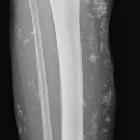fibrosierende Mediastinitis







Fibrosing mediastinitis is a rare non-malignant acellular collagen and fibrous tissue proliferative condition occurring within the mediastinum. On imaging, the condition can sometimes mimic malignancy.
Epidemiology
Although it can potentially present at any age, it typically presents in young adults.
Clinical presentation
Affected patients usually present with signs and symptoms of obstruction or compression of the superior vena cava, pulmonary veins or arteries, central airways, or esophagus.
Pathology
It is characterized by chronic inflammation and excessive fibrosis of mediastinal soft tissues. This may lead to compression and sometimes occlusion of mediastinal structures. There are two main pathological types:
- focal: ~80%
- diffuse: ~20%
Etiology
- idiopathic: most cases , thought to be a form of IgG4-related disease
- Histoplasma capsulatum infection (histoplasmosis): common in the United States and often gives a localized pattern
- Mycobacterium tuberculosis infection (pulmonary tuberculosis)
- concurrent intrathoracic malignancy
- sarcoidosis
- radiation therapy
- drugs, e.g. methysergide therapy
Associations
- Reidel thyroiditis
- retroperitoneal fibrosis
- Behcet disease (rare)
- other autoimmune conditions:
Radiographic features
Plain radiograph
Can be subtle and may be seen as a non-specific widening of the mediastinum. There can be distortion and obliteration of normally recognisable mediastinal interfaces or lines. Other accompanying features include:
- calcification (mediastinal and/or hilar) ~85% (commoner in localized type)
CT
Exact appearance can be variable and dependent on the pattern of involvement. Typically affects the middle mediastinum and may show:
- mediastinal or hilar mass: especially in localized disease
- infiltrative region of soft-tissue attenuation which obliterates normal mediastinal fat planes and encases or invades adjacent structures: diffuse form
Other findings include:
- calcifications of the central mass or associated lymph nodes: especially if there has been preceding histoplasmosis
- tracheobronchial narrowing
- pulmonary infiltrates
MRI
The pattern of involvement is essentially similar to CT. Signal characteristics include:
- T1: typically heterogeneous but overall iso-signal to muscle
- T2: variable with both high and low signal within the same lesion
- T1 C+ (Gd): may show heterogeneous enhancement
Complications
- superior vena cava (SVC) compression/obstruction/thrombosis
- pulmonary hypertension
- esophageal compression
- airway stenosis/obstruction
Treatment and prognosis
Fibrosing mediastinitis can have an unpredictable course, with both spontaneous remission or exacerbation of symptoms being reported.
It usually tends to be slowly progressive. There are three possible avenues for treatment: systemic antifungal or corticosteroid treatment, surgical resection, and local therapy for complications.
Surgical resection of affected region could be considered with localized disease. Some patients with the diffuse pattern show radiographic evidence of improvement with steroid therapy.
See also
Siehe auch:
- Sarkoidose
- Rheumatoide Arthritis
- pulmonale Tuberkulose
- systemischer Lupus Erythematodes
- pulmonale Hypertonie
- Riedel-Thyreoiditis
- Mediastinalhämatom
- retroperitoneale Fibrose allgemein
und weiter:
- einseitig vermehrte Transparenz Thorax
- inflammatorischer Pseudotumor der Orbita
- Mediastinitis
- Obere Einflussstauung
- pulmonary arterial hypertension classification - third world symposium on PAH
- superior vena caval obstruction
- Pulmonalvenenthrombose
- Ursachen für Perfusionsdefekte in der Lungenventilations / -perfusionsszintigraphie
- Pulmonalvenenstenose

 Assoziationen und Differentialdiagnosen zu fibrosierende Mediastinitis:
Assoziationen und Differentialdiagnosen zu fibrosierende Mediastinitis:







